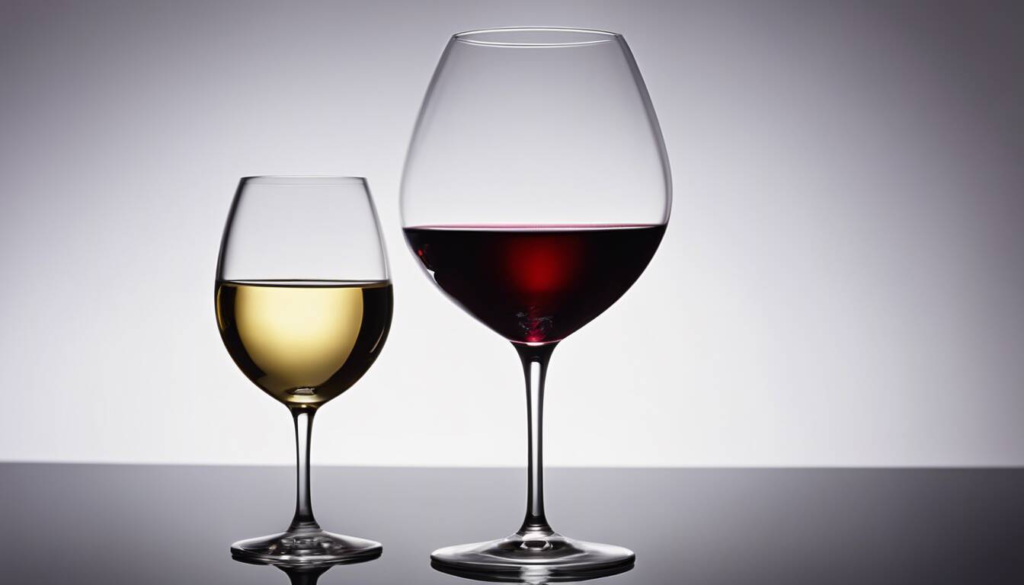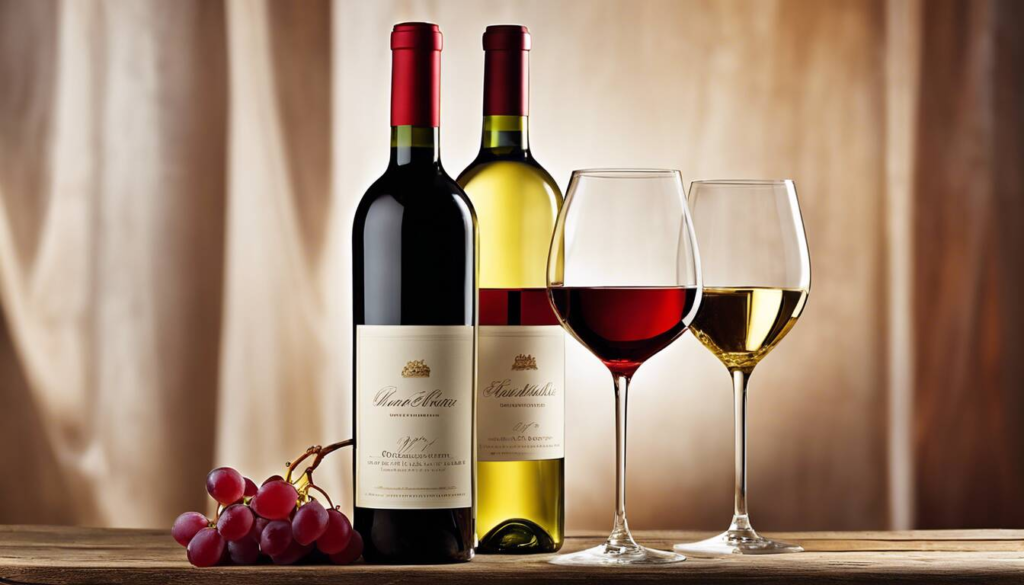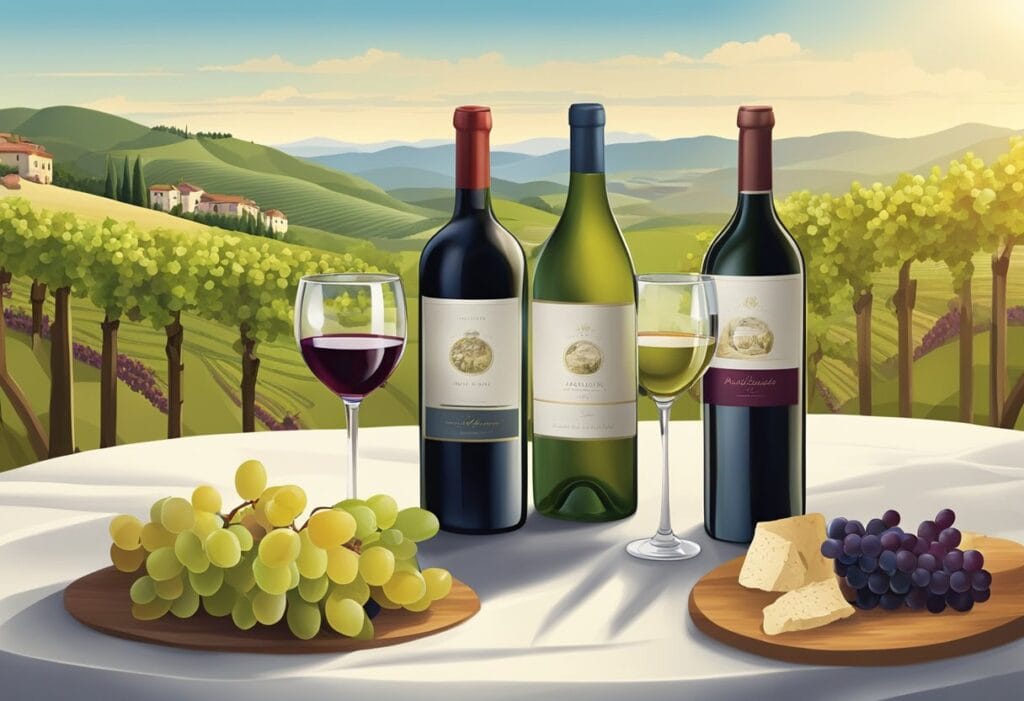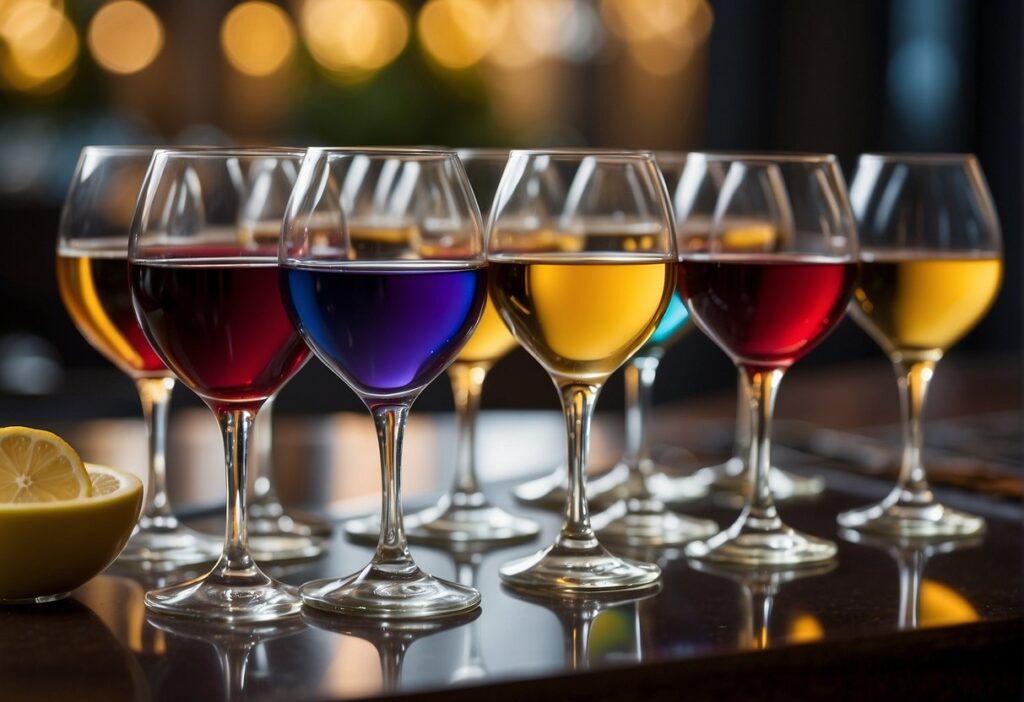Reds and whites come from a world of diverse grapes. While rich dark varieties like Cabernet Sauvignon and Merlot craft our beloved red wines, lighter skinned grapes like Chardonnay and Sauvignon Blanc give birth to the whites we savor. But it’s not just about color. The magic truly unfolds when grape juice meets its skin during fermentation for reds while being separated for whites, revealing an array of unique character and taste. Now let’s embark on a journey to the renowned regions where these exquisite wines are born.
The key difference lies in the grape skin contact during fermentation. Red wines are made with prolonged contact with the grape skins, imparting deeper color and tannins, while white wines are made without skin contact, resulting in a lighter color and crisper profile. Each type offers its unique flavor profiles, with red wines often showcasing berry notes and whites featuring citrus or orchard fruit flavors.

Red and White Wine Varietals
When it comes to wine, the variety of grapes used plays a substantial role in the character and taste of the final product. Red wine varietals, such as Cabernet Sauvignon, Merlot, and Pinot Noir, are crafted from dark-colored grape varieties. These varieties contribute not only their deep hues but also their tannins to the wine. Tannins give red wines their structure and texture, mainly derived from the skins of the grapes during the fermentation process, a method known as maceration.
Maceration involves letting the grape juice sit with the grape skins and seeds during fermentation. The longer this process goes on, the more color, flavor, and complexity are leached from the skins into the wine. Consequently, red wines tend to have richer fruit flavors, often reminiscent of berries such as blackberries, raspberries, or cherries. Additionally, longer maceration times result in deeper hues and more intense flavors.
Notable Red Wine Varietals:
| Red Wine Varietal | Characteristics |
|---|---|
| Cabernet Sauvignon | Known for its bold tannins and rich flavors like black currant and plum. Often described as full-bodied. |
| Merlot | Typically characterized by its softer tannins and notes of red fruits such as cherry and raspberry. |
| Pinot Noir | Renowned for its light to medium body with earthy and fruity characteristics like cranberry or black cherry. |
In contrast, white wines are predominantly sourced from green-skinned grapes like Chardonnay, Sauvignon Blanc, and Riesling. Their distinct colors come from separating the grape juice from the skins before fermentation. This separation prevents pigments from entering the wine, resulting in its characteristic clear, golden, or pale appearance.
The absence of skin contact also means that white wines generally have higher acidity than reds. This acidity contributes to their tart profile and enhances their vibrant fruit flavors which can range from citrusy notes to those of orchard or tropical fruits such as apple, peach, pear, or pineapple. Some white wines even exhibit minerality or secondary flavors offering a wide spectrum of aromas and tastes.
Notable White Wine Varietals:
| White Wine Varietal | Characteristics |
|---|---|
| Chardonnay | Known for its versatility in flavor ranging from fruity to buttery depending on factors such as climate and aging processes. |
| Sauvignon Blanc | Often characterized by its herbaceous and zesty qualities with notes of lime, green apple, or passionfruit. |
| Riesling | Recognized for its aromatic nature with a spectrum of sweetness levels ranging from bone dry to very sweet. |
Understanding these distinctions between red and white wine varietals provides insight into how factors like grape variety and winemaking techniques play pivotal roles in shaping the diverse array of flavors across the wonderful world of wines.
Moving on from this delightful exploration of different wine varietals brings us to an equally captivating discussion about the origins of various wine regions—each with its own unique story to tell.
Origins of Different Wine Regions
Wine regions are like the birthplaces of these incredible wines. Each region has a story, a history that plays a crucial part in how their wines taste. Let’s transport ourselves to Bordeaux, France, famous for its rich, bold red wines. The climate there ensures the grapes receive the perfect amount of sunshine and rain, resulting in big and juicy growth.
Contrastingly, Burgundy, also in France, is known for elegant, complex Pinot Noir and Chardonnay whites that can be steely and buttery because every sip tells you about the limestone soils and cooler climate.
Then there’s Napa Valley in California—the sun shines brighter there, giving the grapes extra time to ripen. It’s like every grape soaks up all that warm light before being turned into delicious wine. That’s why Napa Valley is famous for its big, rich Cabernet Sauvignon.
On the other hand, Champagne in France produces some of the world’s best sparkling white wines. The chilly climate creates the perfect conditions for growing Chardonnay, Pinot Noir, and Pinot Meunier grapes used in making flavorful champagnes.
These regions aren’t just producing any wine; they’re crafting masterpieces by nature itself.
Over to Loire Valley, again in France—this place is like an artist’s canvas. Their soil has layers upon layers of different elements like limestone or clay that add distinctive flavors to their white wines like Sauvignon Blanc and Chenin Blanc. The flavors tell a story of the land they come from.
Then we have Alsace, also in France—a region where wines burst with vibrant flavors thanks to the sunny days and cooler nights. The Riesling from this region is like experiencing a summer walk through an orchard.
“Every little detail about these places adds up to something amazing when it comes to crafting delicious wine.”
It’s incredible how each region intricately shapes its wines with its own unique environmental factors—sunlight exposure, temperature variations, soil composition—all weaving together to create distinct reds and whites celebrated around the world.
Understanding the origins of wine is pivotal to truly appreciating its intricacies. Let’s now venture into unraveling the fascinating realm of distinguishing aromas in red and white wines.
Distinguishing Aromas in Red and White Wines
When it comes to the world of wine, the ability to pick out and identify specific aromas is like being able to read a unique story within each bottle. Each whiff speaks volumes about the grape varietal, winemaking process, and even the region where the grapes were grown.
Red wines often showcase a rich tapestry of aromas that can transport you through a wooded forest or a sun-drenched orchard. Imagine walking through a vineyard on a crisp autumn day when the air is filled with the scent of ripe fruit and earthy undertones. In red wines, you might encounter enchanting aromas of cherries, strawberries, plums, or even darker fruits like blackberries or currants. These flavors may be interspersed with intriguing elements such as leather, tobacco, and pepper.
White wines, on the other hand, offer a lighter and more refreshing olfactory experience. Instead of deep hues and dark fruits, picture a stroll through an airy citrus grove or a blossoming garden. The aroma of freshly sliced green apple or pear might greet your senses before yielding to tropical notes such as pineapple, mango, or guava. And just like walking through a fragrant flower garden, white wines often present delicate floral or herbal nuances that add yet another layer of complexity to their aromatic profile.
It’s important to note that these aromatic components aren’t just whimsical descriptions; they’re rooted in the unique chemistry of each grape varietal. For instance, compounds like terpenes contribute to the floral and citrus notes in many white wines, while phenolic compounds like anthocyanins play a major role in developing the vibrant fruit profiles found in red wines.
Picture sitting down with a glass of Cabernet Sauvignon—a full-bodied red wine known for its deep fruit flavors. As you take in its heady aromas, you might discern an enticing blend of ripe blackberry, plum, and subtle hints of vanilla from aging in oak barrels. On another occasion, opening a bottle of Chardonnay could fill your senses with a delightful mix of citrus zest, almond, and perhaps even a touch of buttery richness from malolactic fermentation.
The distinct aromas in red and white wines offer an immersive sensorial experience that enriches every sip. But how do these aromas influence our overall enjoyment of each wine? Let’s explore this further.
Tasting Notes: Comparing Red and White Wines
When you take a sip of wine, it’s like unlocking a treasure chest of flavors. Each wine has its own distinct personality, and understanding these nuances can make your drinking experience even more enjoyable.
Let’s start with red wines. Imagine the rich taste of blackberries, the sweet tartness of raspberries, the boldness of currants, and the lusciousness of black cherries and plums dancing on your palate. These fruit flavors often dominate red wines, creating a delightful complexity that is a hallmark of many varietals. The aging process in oak barrels can add additional layers of flavor, bringing out hints of vanilla, subtle smokiness, and a touch of luxurious chocolate to the mix. With each sip, you can unlock a symphony of tastes that coat your mouth in a delightful richness.
Now, let’s turn our attention to white wines. Picture tasting notes like zesty lemon, tangy lime, refreshing grapefruit, crisp green apple, and succulent pear. In some white wines, you might also detect subtle undertones of honey, silky butter, or roasted nuts. These flavors are influenced by the ripeness of the grapes used and the precise winemaking techniques employed. Together, these elements create a unique taste profile that is as diverse as it is enchanting.
It’s important to remember that while these general flavor profiles hold true for many red and white wines, each individual bottle will surprise you in its own unique way. From the earthy depth of a robust red to the refreshing citrus burst of a delicate white wine, every bottle has its story woven into its very essence.
The art of tasting wines goes beyond just drinking – it’s about appreciating the intricate blend of flavors that tell the story of where the grapes were grown, how they were nurtured, and the expertise that went into crafting them into a masterpiece.
As we continue our exploration through the captivating world of wine and seek to understand what makes each varietal special, next up we’ll delve into the unique characteristics that define both red and white wines.
Unique Characteristics of Red and White Wines
When you pour a glass of red wine next to a glass of white wine, have you ever considered what sets them apart? Let’s uncover what makes them distinct.
Red Wines
Red wines have a rich, deep color derived from the grape skins. They also boast robust flavors that can span from berries to earthy and spicy notes. When you take a sip, you might notice something on your tongue that feels dry or slightly rough – that’s the tannins. Tannins give structure to the wine and make your mouth water, which is why some people think they’re perfect with meatier foods or sharp cheeses.
The heavier body and intense flavors of red wines pair well with bold dishes like beef stew or flavorful cheese plates. Imagine biting into juicy steak and savoring it with a sip of bold red wine; they’re like old friends who bring out the best in each other.
White Wines
On the other hand, when it comes to white wines, it’s an entirely different experience. Just as a slice of lemon can brighten up a dish, acidity enlivens white wines. But wait, there’s more! Picture yourself by the sea, under the warm sun enjoying a plate of grilled seafood paired with a glass of refreshing white wine—the acidity complements the food perfectly.
And here’s something interesting—white wines can have different aromas just like red wines do. Some might remind you of citrus fruits like lemons or oranges, while others may have hints of green apples or tropical fruits like pineapples.
Therefore, it’s no wonder that these zesty, refreshing qualities make white wines an excellent match for lighter dishes such as salads, sushi, or creamy pasta sauces. The lightness and acidity in white wines create a harmonious balance with these types of food.
White wines are often praised for their ability to enhance and complement lighter fare such as seafood, poultry, salads, and creamy sauces.
These unique attributes not only define red and white wines but also influence how they pair with different types of food. Understanding these characteristics adds depth to the experience of enjoying each type of wine and selecting the perfect pairing for your meals.
Understanding the intricate interplay between wine characteristics and food pairings enriches the overall drinking experience. Now let’s delve into the world of popular wine blends and how they stack up against each other.
Popular Wine Blends: Red vs White

There is an artistry to blending; it’s like creating a delicious meal, only with grapes. The goal is to achieve a harmony of flavors that narrates a story about the region, the winemaker, and the varietals involved. Red wine blends often combine potent varietals such as Cabernet Sauvignon, Merlot, and Syrah to create complex flavor profiles. Each grape brings something unique to the mix: Cabernet Sauvignon offers structure and tannins, Merlot contributes supple fruitiness, and Syrah adds depth and spice.
In contrast, white wine blends can encompass Chardonnay, Sauvignon Blanc, Viognier, and other varietals. These wines aim for diversity in flavor experiences – sometimes delivering tropical fruits and floral notes in one delightful sip. The interplay of acidity in these wines can be skillfully crafted by the winemaker to bring balance and zest to the palate.
Many would agree that certain wine regions have made a name for themselves with their unique red and white blends. In France’s Rhône Valley, you’ll find rich and smooth red blends that showcase Grenache, Syrah, and Mourvèdre varietals. These wines offer up wild herbs, rich dark fruit flavors, and a hint of earthiness that makes them truly remarkable.
On the other hand, Tuscan blends in Italy are known for their full-bodied red wines crafted from varietals like Sangiovese, blended with smaller amounts of native Italian varietals such as Canaiolo and Colorino. These blends boast an earthy quality that is enriched with ripe fruit flavors and floral aromas.
All this talk about amazing wine blends might stir your curiosity about trying them! There’s no end to exploring the world of incredible tastes as these wines often paint a vivid picture of tradition, innovation, passion, and artistry—all in one glass.
So whether you’re enticed by the complexity of red wine blends or tempted by adventurous white wine blends, there’s something out there for every palate—each bottle with its own story waiting to be uncorked.
Exploring the world of wines is not just about taste but about understanding the stories and cultures behind them. Each bottle holds a unique experience waiting to be shared and enjoyed with friends or simply appreciated on a quiet evening.

